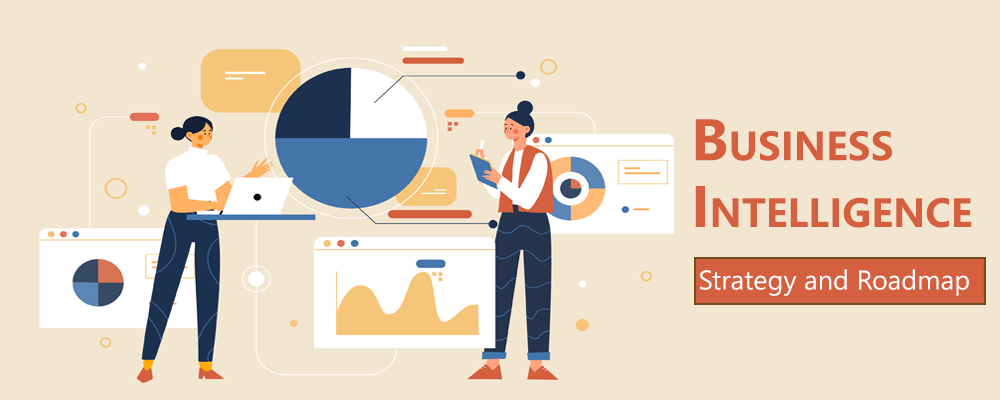The business intelligence strategy is viewed as a roadmap designed to help companies measure their performance and strengthen their performance through architecture and solutions. Therefore, creating a successful BI strategy roadmap will have a very positive impact on the efficiency of the organization. How to Develop a Smart BI Strategy? Here we represent some implementations of business intelligence strategies to help you make your job easier.
What Is a Business Intelligence Strategy?
Business intelligence strategy is the process of implementing a BI system in your business. This is a blueprint showing how you will use business data in your company. The process of implementing BI in business involves defining key stakeholders, defining goals, assessing the situation, and finding KPIs that help measures your effort to achieve these goals.

Benefits Of Implementing a BI Strategy
It is important to implement business intelligence software in business but it is more important the way you implement it. Like how you make decisions and invest in the right tools to get a visualization of your data. Below we have discussed some of the benefits of implementing a BI strategy.
Quick and accurate reporting: Implementing BI strategy in business provides ready-made templates or customized templates for monitoring business-level KPIs using a variety of data sources, including sales, financial, and operations data. These real-time reports help business owners make quick decisions. Most reports include easy-to-read visualizations such as graphs, tables, and charts.
Save time and money: Implementing a business intelligence strategy and roadmap will not only help you make better strategic decisions but will also save your business time and money.
Increased customer satisfaction: Applying business intelligence can help companies understand customer behavior and patterns. Most companies are taking customer feedback in real-time and this information can help businesses retain customers and reach new ones. These tools can also help companies identify buying patterns, which help customers experience employees to anticipate needs and provide better service.
Improved risk management: Implementing a business intelligence strategy also helps with risk management. By pre-thinking every step, you don’t find yourself in difficult situations that could cost you money and time. Additionally, you can also spot vulnerabilities in your process and deal with them quickly.
Valuable business insights: Businesses can measure employee productivity, revenue, overall success as well as department-specific performance. It can uncover strengths and weaknesses as BI tools help organizations understand what is working and what is not. Alerts are easy to set up and can help track these metrics and help busy executives stay on top of the KPIs that matter most to their business.
Competitive analysis: The most important advantage of implementing Business Intelligence in a business is a competitive advantage. The ability to manage and manipulate large amounts of data is a competitive edge in itself. Furthermore, budgeting, planning, and forecasting is an incredibly powerful way to stay ahead of the competition, goes beyond standard analysis, and is also easy to perform with BI software. Businesses can also track their competitors’ sales and marketing performance and learn how to differentiate products and services.
How to develop a BI strategy?
There are several steps to follow when developing a business intelligence strategy.
Step 1. Define the current state
A stable business intelligence strategy is the foundation of the current use of business intelligence. To unleash the full potential of business intelligence and take your organization to the next level, you need to define simple questions like:
- Where are you at the moment?
- What do you want to achieve?
- What is possible?
If there is a lack of consensus on the vision among the stakeholders, the BI strategy may not go very far. In particular, there must be a precise alignment between your BI strategy and the strategy of the company.
Step 2. Build a business intelligence roadmap
Business intelligence starts with strategic planning. Therefore, your next step is to prepare a BI roadmap. This is your overall strategy document that outlines your vision, goals, and ways to achieve them.
It describes what is in scope, what is not, and the general hierarchy. There are several stages of BI implementation in any organization, so the project roadmap should include goals, content, timing, and implementation method.
Step 3. Set KPIs and requirements
At this stage, you need to define the main business goals that you will achieve with the help of a BI development strategy.
- What business goal do you want to focus on?
- What indicators can improve your performance and strategy?
- Which KPIs and evaluation indicators define the task as complete?
- Which data sources will be used?
Look at your data source and divide all content into three categories:
- Tracked indicators: data that you will follow regularly but will not be used as performance measures.
- Untracked metrics: data you will not track. However, these data should be available for future analysis.
- KPI (Key Performance Indicator)-the indicator you will use to measure performance. This will be a subset of the metrics you track.
Step 4. Choose a qualified BI tool
You need to comprehensively assess the industry, company size, and business needs, conduct market research and select the appropriate BI tools.
Step 5. Create a prototype
It is a small project that validates a technical concept by proposing a number of simplified tasks, verifying the hypothesis, testing the functionality of the product, and ensuring that the concept can be implemented or vice versa. In addition, it helps in finding the source data, and when the end-user accesses the data, some changes can be made to ensure the security of the data at large.
Step 6. Set up a team
The best way to build a team is to gather experts from different departments of the company, who provide specific insights, hold differing perspectives, and make architectural, technical, and strategic decisions. Generally, there are five main roles:
- BI Director: the person with business and technical skills who can generate insights and drive the realization of BI.
- BI Engineer: the person who designs, builds, implements, and sets up BI systems.
- Business Analyst: The person who provides expertise in data validation, processing, and visualization to other team members and who translates analysis into actionable insights.
- Data Scientist: A person who uses analytics, statistical tools, and machine learning to extract actionable value from big data.

Milan Desai
Chief Technology Officer
Milan Desai has more than 20 years of industry experience in working with clients to solve business problems. Passionate about leveraging technology for improving the quality of life and optimize the use of resources. Currently, working on utilizing data to drive business decision making process and user understanding of key metrics that drive the organization and markets in general. Co-founder of EzDataMunch – the first BI Apps store in the world.

